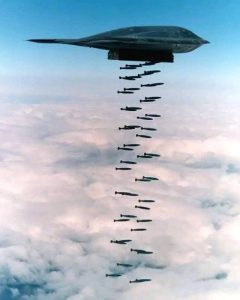
Iran is reeling in anguish and shock as three of its most treasured nuclear sites were obliterated overnight by America’s stealth bombers.
The B-2 Spirit, carrying powerful warheads, soared through the night sky on June 21, carrying the most powerful non-nuclear weapons in America’s arsenal. As the world held its breath, these $2 billion worth of stealth bombers delivered a crushing blow to Iran’s nuclear ambitions.
The Fordow, Natanz, and Isfahan facilities went up in flames.

Born from the now-defunct Advanced Technology Bomber (ATB) program in the late 1970s, the B-2 was designed to slip past Soviet air defences undetected. Its radar cross-section is roughly that of an eagle, thanks to its smooth, faceted surfaces and radar-absorbent materials. Unlike traditional bombers, the B-2 lacks a tail, fuselage, or vertical stabilisers, making it nearly invisible to enemy radar.
But Stealth comes at a cost. Each B-2 carries a price tag of $2.13 billion, making it the most expensive aircraft ever built. Only 21 were produced, with 19 still in service after one crash and another retired due to damage.
The B-2 Spirit represents the pinnacle of stealth bomber technology, a flying wing design that revolutionised aerial warfare with its unprecedented combination of low observability and precision strike capability. Its smooth, continuous curves and lack of vertical surfaces make it virtually invisible to radar, while its composite skin absorbs rather than reflects electromagnetic waves.

The aircraft’s four General Electric F118 engines are buried deep within the airframe to minimise infrared and acoustic signatures, with serpentine inlets that prevent radar waves from reaching the engine blades. This meticulous attention to stealth allows the B-2 to penetrate the most sophisticated air defence networks, approaching targets undetected before delivering its devastating payload.
What truly sets the B-2 apart is its remarkable versatility in weapons delivery. The bomber’s internal bays can carry everything from eighty 500-pound JDAM precision bombs to two massive 30,000-pound bunker busters capable of destroying fortified underground facilities.
Its advanced AN/APQ-181 radar system provides synthetic aperture mapping that enables targeting in any weather conditions, while the aircraft’s sophisticated navigation suite allows it to strike within meters of intended targets after intercontinental flights.

The B-2’s ability to conduct marathon 44-hour missions with multiple aerial refuellings means it can reach any point on the globe from its home base in Missouri, a capability demonstrated in operations from Kosovo to Libya to the 2025 strike on Iran’s nuclear facilities.
Yet this technological marvel comes with extraordinary costs and complexities. Each B-2 requires climate-controlled hangars and painstaking maintenance to preserve its delicate stealth coatings, with operating costs exceeding $130,000 per flight hour. The aircraft’s sophisticated systems demand constant upgrades to counter evolving detection technologies, from new radar frequencies to advanced infrared sensors.
On Saturday night, six of the bat-winged bombers, each carrying two 30,000-pound GBU-57 Massive Ordinance Penetrator bombs, approached their targets with eerie silence. Their mission: destroy the heavily fortified enrichment facilities.
The bombers flew from Whiteman Air Force Base in Missouri, refuelling multiple times midair during the 15,000-mile round trip – a capability that allows the U.S. to strike anywhere on Earth without relying on forward bases.
The Fordow strike represented the B-2’s most challenging combat mission yet. The facility’s mountain shielding required bombs capable of penetrating hundreds of feet of rock before detonating in precisely timed bursts to collapse underground chambers. Only the B-2 could carry these massive bunker busters while remaining invisible to Iranian air defences.
As President Trump announced the successful operation, the B-2s were already returning home, their bomb bays empty but their legacy secure.
“Tonight, I can report to the world that the strikes were a spectacular military success. Iran’s key nuclear enrichment facilities have been completely and obliterated. Iran, the bully of the Middle East, must now make peace. If they do not, future attacks will be far greater and a lot easier,” President Donald Trump said in a late-night address from the White House on June 21.
This mission may have been the Spirit’s last major combat operation before retirement, but it demonstrated why this 70s-era aircraft remains unmatched in its ability to deliver overwhelming firepower with stealth and precision.
The attack also highlighted the B-2’s paradoxical nature – simultaneously the most advanced and most fragile weapon in America’s arsenal. Each aircraft costs $135,000 per flight hour to operate and requires climate-controlled hangars.
The 2008 crash of a single B-2 resulted in a $1.4 billion loss, equivalent to an aircraft carrier. Yet when absolute stealth and overwhelming firepower are required, no other platform can match the Spirit’s capabilities.
Now in its final years of service, the stealth bomber headlined America’s air dominance. Such a ghostly presence that strikes without warning and vanishes without a trace!
The era of the B-2 may be ending, but its impact on warfare is indelible.




